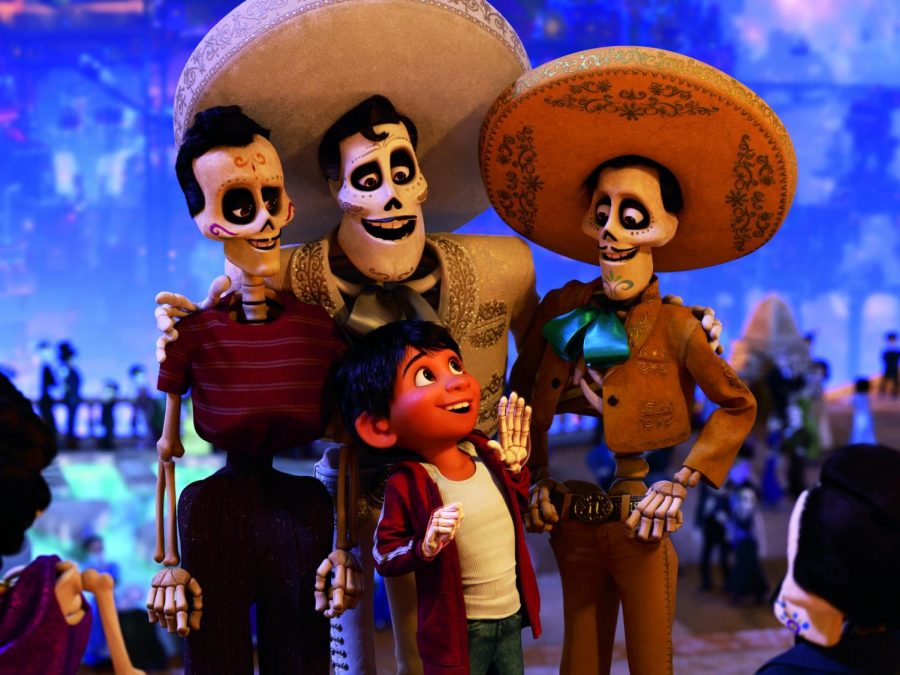Coco’s International Popularity Rooted in Its Family-Oriented and Hispanic Themes
Disney-Pixar’s newest animated movie Coco has been experiencing unbelievable success. The film takes place in Mexico on El Día de Los Muertos (The Day of the Dead). It focuses on a boy, Miguel Rivera, who has musical aspirations. However, the shoemaking Rivera family has had a strict no-music policy ever since an ancestor left the family to pursue life as a musician. When Miguel accidentally crosses over to the Land of the Dead, he must enlist the help of his deceased ancestors in order to return home. He befriends Hector, and together they uncover the truth about Miguel’s family history.
The film focuses on the importance of family, but it also encourages individuality and pursuit of personal ambitions. One of the movie’s most striking aspects is that it is almost entirely centered on death; however, it never becomes dark or depressing. The Land of the Dead is a vibrant and colorful place as alive as the Land of the Living.
Coco is receiving praise left and right. It earned a 96 percent “freshness” score from Rotten Tomatoes, with the Critics Consensus saying, “Coco’s rich visual pleasures are matched by a thoughtful narrative that takes a family-friendly – and deeply affecting – approach to questions of culture, family, life, and death.”
Particularly positive reactions are coming from the Hispanic community. Many Mexicans and people of Mexican or other Latin-American descent feel a strong connection to the film. Coco manages to steer clear of stereotypes and comes across as authentic rather than culturally appropriated. Details such as the marigold bridge to the Land of the Dead (marigolds are a major Día de los Muertos decoration), the ofrenda (family altar), alebrijes (spirit animals), and the dead’s faces resembling sugar skulls provide authenticity. Miguel’s tough-loving Abuelita threatens to hit him with her chancleta (flip flop) one minute and feeds him tamales the next. There are an abundance of reviews online that depict just how much Coco hit home for Latinos.
OH Spanish teacher Ms. Jennifer Chacon, who is Venezuelan, was greatly moved by the film. She states, “It gives a beautiful message about family values…The family is always together; they’re so supportive of the children. Most of the time, that’s how it works with Hispanics. It’s always big families and everyone is always welcome.”
Chacon adds, “We take death as something creepy and ugly. And it’s interesting how they take death as something happy; it is a beautiful place that is waiting for us. Death being associated with happiness instead of sadness – I think that’s a strong statement right there.” Chacon believes the colorfulness of the film and the beautiful music are also notable components. On whether the movie accurately represents Hispanic culture, Chacon says, “I think it absolutely does a good job representing Mexican culture. It has mariachis; it has a lot of stuff. However, you cannot say that it represents the whole Hispanic world.”
Furthermore, the movie is striking a cord with Latinos who have been trying to reclaim the image of their culture and identity as anti-immigrant (especially anti-Mexican) sentiments grow in the US. Claudia Puig, president of the Los Angeles Film Critics Association, describes Coco as “a soothing tonic for a community that’s really been beleaguered and disrespected… It’s almost like a rebuke to Trump and the way he sees Mexicans as problematic and horribly stereotyped. This movie is showing a completely different side.”
The movie is unapologetic in its use of Spanish, with many Spanish phrases coming up and most of its songs being sung in the language. It does not bother to translate anything, thus further immersing the audience in the true world of Coco. This could be indicative of a changing narrative in the age of globalization and increasing international connections. One needs only to look at what was the most successful song in all of 2017: “Despacito.” A record-breaking song completely in Spanish became America’s favorite summer tune.
While Coco may be specifically aimed at a Hispanic audience, it is not any less enjoyable for people of other backgrounds. If anything, it serves as an eye-opener and introduces them to other cultures’ customs and values. For instance, OH sophomore Alexa Domash says, “The movie showed me the importance of family and respect for your elders, a message I feel has been lost among today’s generation.” Domash has a backpack with Day of the Dead symbols on them. She quips, “I knew pretty much nothing about Day of the Dead; I just thought it was a cool backpack. But now I understand what my backpack really means!”
Coco’s positive reception is reflected in its financial success. It opened in Mexico on October 27, where it grossed $56.1 million in only 20 days, making it the highest grossing film in Mexican history. The movie opened in the U.S. on Nov. 22, the Wednesday before Thanksgiving, and it has held first place at the box office for the three weekends since then.
Coco has found success in other foreign countries as well. For example, it has reached the top of the Chinese box office and is Pixar’s most successful movie ever in China. So far, the film has grossed $135.5 million domestically and about $390 million worldwide. Even more triumphs may be on the way for Coco, as it has yet to open in other major markets such as Australia, the U.K., Japan, and Brazil.

















